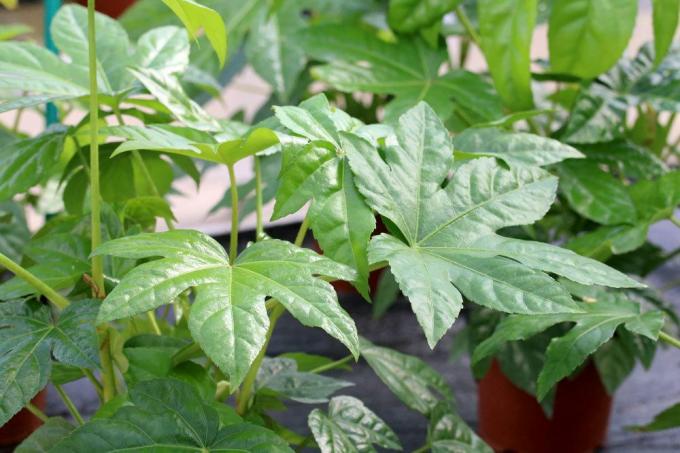
table of contents
- Characteristics
- care
- Location
- plants
- to water
- Fertilize
- Cut
- Multiply
- Diseases
- Pests
Profile and care information open +conclude -
- Flower color
- White
- Location
- Partial shade, shady, sunny, full sun
- Heyday
- August September October
- Growth habit
- upright, spreading, bushy, perennial, subshrub, overhanging
- height
- 1.5 to 6 meters high
- Soil type
- sandy, loamy, clayey
- Soil moisture
- moderately dry, fresh
- PH value
- neutral, weakly alkaline, weakly acidic
- Limescale tolerance
- Calcium tolerant
- humus
- rich in humus
- Poisonous
- Yes
- Plant families
- Araliaceae, Araliaceae
- Plant species
- Indoor plants, container plants, garden plants, balcony plants, ornamental plants
- Garden style
- Terrace garden, pot garden, winter garden, residential garden, ornamental garden
Fatsia
A Far Eastern charm emanates from the Fatsia Japonica, which makes it one of the most popular exotic plants. The fast-growing plant is very frugal in terms of care and is also perfect for inexperienced plant lovers. Nevertheless, a few details should be taken into account when keeping them, which Plantopedia describes in detail.
Characteristics
- Name: Zimmeraralie
- scientific name: Fatsia Japonica
- Plant family: Aralia family
- Origin: Asia
- Height: about 1.5 meters - up to six meters outdoors
- Preferred location: south window
- Limescale tolerance: good (except for the leaves)
- special properties: fast growing
- Toxic: limited
- Care needs: low / simple
care
Easy to maintain due to low demands, this is how the indoor aralia shows itself. With only a little effort you can enjoy the Fatsia Japonica for many years, if you stick to the few care details, as can be found in the following care instructions are. In addition, you can find out here whether the indoor aralia is really poisonous, as it is often claimed.
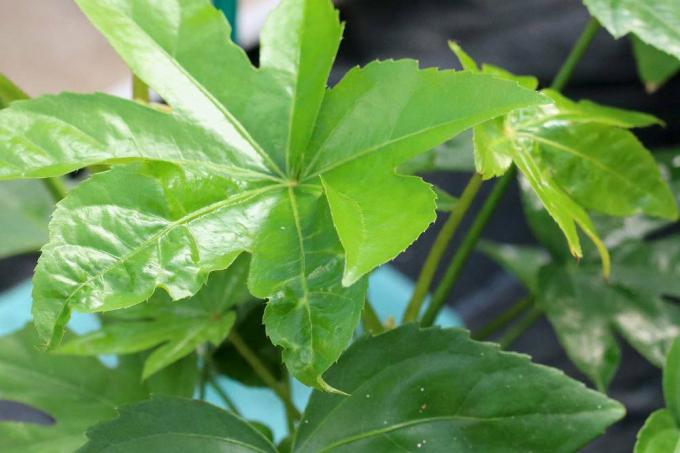
Location
The indoor aralia likes it very sunny and thrives particularly well in a lot of sunlight. In summer she likes to stand outside on the terrace or balcony. Here it should not get too much sun and, above all, no hot sunbeams, as the leaves can be sensitive to sunburn. Otherwise, the Fatsia Japonica has the following requirements for an optimal location.
- Light conditions as a houseplant: partly sunny / full sun - ideal at the south window
- Outdoor lighting conditions: clear space without direct sunlight
- high humidity (at least 60 percent)
- optimal ambient temperature: between 15 degrees Celsius and 18 degrees Celsius (during growth)
- cooler location in winter
- Avoid cold drafts and dry heating air
- Choose a location that is not accessible to cats, as the indoor aralia is highly poisonous for cats
TIP: If the leaves are hanging and your indoor aralia shows itself with light green leaves and heavily lignified shoots, then it is usually too dark. Move it to a lighter spot and it will recover quickly.
Soil conditions
Although this Far Eastern beauty cannot spend the winter outdoors, it will reward you with an enormous growth spurt by planting it in the garden bed. It makes no special demands on the earth. They are usually satisfied with normal garden soil, which ideally has the following properties.
- nutritious
- permeable and loose
- evenly moist
- also slightly clay or sand
- pH value: acidic or calcareous (alkaline)
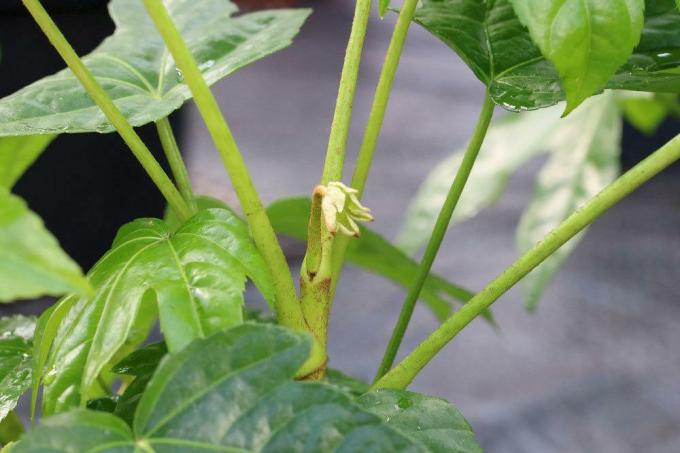
Substrate
Cultivated indoor areas should not be planted in conventional potting soil, as this threatens to condense quickly and thus provoke mold and waterlogging. It is advisable to use a high quality substrate here. This should have the same properties as the garden soil and have a high nutrient content.
plants
Since the indoor aralia is one of the fast-growing plants, it is important when planting that sufficient space is made available so that it is not hindered in its growth. In addition, the soil or the substrate must be loosened over a large area in the immediate vicinity so that water can flow through it well and develop a certain degree of moisture.
Proceed as follows:
- Dig a planting hole that is at least twice as large as the plant ball
- Fill the ground with about two centimeters of gravel, pottery shards or quartz sand (drainage)
- Insert Fatsia Japonica in the middle
- Mix the excavated earth with compost
- Refill the planting hole with soil
- do not step on the side of the earth
- only press soil onto the plant stem (for plant stabilization)
- Pour generously
- if it sags in the following 1-2 weeks, fill up with soil
Outdoor planting
The Fatsia Japonica should only be planted outdoors when the outside temperature is constantly above 15 degrees, which is usually the case from mid / late May. However, since the climate continues to change from year to year, the time indicated is only of limited importance, but the temperature determines the best time to plant.
Planting should not be done later until the beginning / middle of August, because then the end of the growing season is just around the corner and the Fatsia Japonica is slowly adjusting to winter dormancy. In addition, the outdoor season usually ends by the end of October at the latest, when the first night temperatures drop below 10 degrees Celsius.

cultivation
In theory, Fatsia Japonicas can be grown year round. However, she prefers an undisturbed winter season, which she wants to spend in peace and not be burdened with planting and transplanting. In addition, it stops growing during the cold season, making it difficult for it to establish itself in new substrate. This increases the risk that it will not survive cultivation. You can tell when the leaves begin to sag.
It is better to plant the plant in a pot or tub from February at the earliest. At this point she has awakened from its hibernation and the new growth phase is almost around the corner. It can be planted at room temperature around 18 degrees Celsius until the end of October.
Repot
The indoor aralia should be repotted every two to three years. After that, the quality of even high-quality substrate is usually no longer optimal and fresh substrate is required. When repotting, proceed in the same way as when planting. Make sure that the pot / tub diameter is at least twice as large as the bale diameter. The roots must be thoroughly freed from old earth.
The pot and bucket should have a drainage hole on the bottom through which excess water can run off to avoid waterlogging. A coaster catches this and prevents unsightly water stains on window sills and other documents. Drainage, as described under "Planting", also reduces the risk of waterlogging.
to water
The Fatsia Japonica needs continuous moisture in the optimal care, which is why the soil / substrate must be watered regularly. Standing in the warm sun, your water requirement is higher and daily watering is advisable. The cooler it is, the less water it needs. The soil / substrate must not dry out completely. As soon as the top layer of the earth cannot be pressed in more than a centimeter with the thumb, it is essential to pour. Likewise when the leaves begin to sag.
Although the indoor aralia tolerates and needs lime in the soil, it does not like this on the leaves. Lime-containing irrigation water leaves unsightly stains and lays a matt finish on the otherwise shiny leaves. Therefore, you should always use lime-free water, such as natural rainwater or stale tap water.
Fertilize
Since the Fatsia Japonica is one of the fast-growing plants, its nutritional requirements during the growing season are quite high. For this reason, regular fertilization is essential for optimal care. If you follow the instructions below when fertilizing, the healthy Fatsia Japonica will reward you with vigorous growth.
- Start of fertilization: March
- End of fertilization: September
- Fertilizer break: between October and February (winter rest)
- Fertilizing rhythm in spring: every three to four weeks
- Fertilizer rhythm in summer: every two weeks
- Fertilizer: liquid fertilizer is optimal for green plants (reaches the partially deep root ends better)
- Alternative fertilizer: work compost into the garden soil once in spring and once in summer
- Additional fertilizer: in the middle of summer fertilize the soil with a little algae lime if necessary
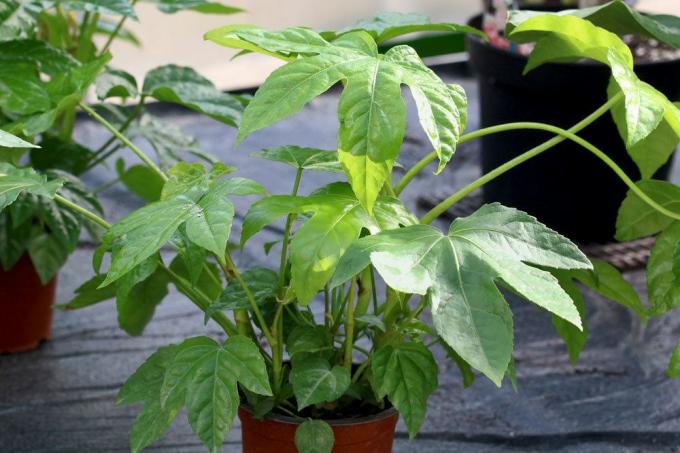
Cut
The room aralia is usually very easy to cut. However, older specimens are a bit sensitive to cutting tools, as they are more susceptible to pathogens that can be transmitted via scissors and knives. Illnesses could be the result. If you have an old Fatsia Japonica, you should only cut it if it is absolutely necessary and thoroughly disinfect the cutting tool before use. Form and normal care cutbacks or cuts that are used to regulate the size, which you can easily perform, come into question.
- best time: shortly before and / or after hibernation in February and / or October
- is cut up to shortly before the "eye"
- shortening the shoots ensures bushy growth
- Cut off withered and dry parts of the plant
- Shorten the roots a few centimeters at least every two to three years (ideal for repotting)
Cutting tool
For lignified shoots, secateurs are better than a knife, as this increases the risk of Frayed wound edges increase, making it easier for fungal infections and bacteria to get into the plant to get. In addition, water can settle in the frayed wound edges of the room aralia and in this way trigger mold infestation. Young, green shoots, on the other hand, can be cut well with a sharp knife. It is very important, especially with old room items, that the cutting tool is disinfected before use.
There are various options available to you for this:
- Immerse in boiling water for ten minutes and then rub cutting blades with alcohol
- Use disinfectants such as Sagrotan
- Hold for two minutes over a gas bunsen burner flame
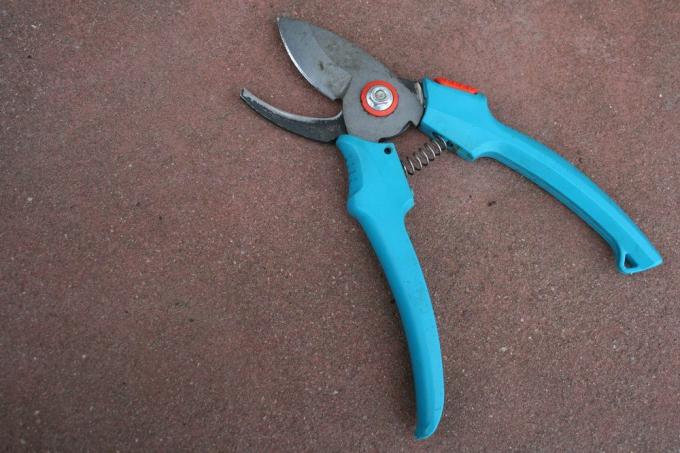
Overwinter
The room aralia is less sensitive to frost than some might think. It can withstand temperatures down to minus six degrees Celsius. However, you cause problems with the cold dampness that exists in Central Europe and do not allow it to survive the local winter months. For this reason, the indoor aralas standing outdoors should always be relocated to winter quarters in mid / end of September. A cooler temperature is also desirable when it is kept in the room, so that the Fatsia Japonica can optimally spend its natural winter rest.
You should meet the following requirements of Fatsia Japonica:
- Ambient temperature: between 10 degrees Celsius and 15 degrees Celsius
- Lighting conditions: bright - no direct sunlight
- no heating air in the immediate vicinity
- Protection from cold rain or snow
- no fertilizer
- Pour little, but do not let the soil dry out
Multiply
Propagation of a Fatsia Japonica can be easily done by two different methods.
sowing
For sowing, you will need seeds, which you can find in the berries that occasionally form in the fall. They usually mature in winter. Then the time has come to take the seeds from them. It is important that the fresh seeds are sown quickly, as they usually only have a short-term germination capacity. Seeds from the gardening trade have been specially processed for a longer shelf life / germinability.
The instructions describe how to sow correctly:
- Fill the cultivation box or small container with potting soil
- Spread seeds on the earth
- Cover with about two or three centimeters of soil (dark germs)
- Moisten the soil well
- use a spray bottle with a soft jet of water to keep the seeds in place
- stretch a transparent, translucent plastic film over the container (increases the humidity)
- open the foil once a day to ventilate
- Keep potting soil evenly moist - but do not over-wet
- Location: bright without direct sunlight
- Ambient temperature: between 20 degrees Celsius and 22 degrees Celsius
- Germination time: approx. 28 days
- Transplanting: when a size of around five centimeters is reached
TIP: If you plant three or four cuttings pulled from the seed in a planter, it will quickly grow into a bushy, dense specimen.
Cuttings
If you have cut your room aralia, the cut shoots are ideal for propagation. Proceed as described below.
- remove all but the top two pairs of leaves
- prepare a planter with nutrient-poor soil
- suitable soil: earth-sand mixture
- put the cutting two-thirds into the ground
- press the soil around the shoot firmly (for stability)
- Water the soil well, but avoid waterlogging at all costs
- Pay attention to uniform soil moisture - the soil must not dry out
- Location: bright, but not in direct sunlight
- Ambient temperature: between 20 degrees Celsius and 22 degrees Celsius
- if roots have developed, new shoots and leaves are formed
- Repot when at least two new shoots can be seen
TIP: Do not be confused if the leaves of the cuttings of the room aralia initially droop. This is normal because there is no root supply.
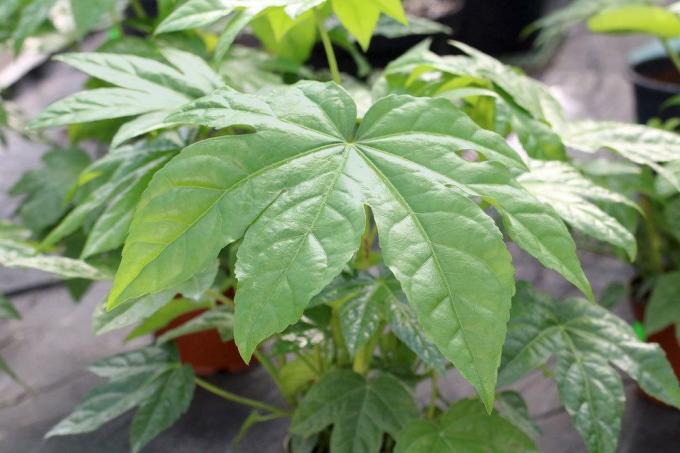
Diseases
The Fatsia Japonica is robust against diseases. Mostly it is due to insufficient or incorrect maintenance. Most often there is root rot, which is caused by waterlogging. This can be seen when the leaves are hanging, a musty smell rises from the earth and the indoor aralia becomes increasingly stunted. Since these symptoms are usually only noticed at an advanced stage, the Fatsia Japonica can no longer be saved and can only be disposed of.
Pests
Especially very humid and very dry air occasionally attract pests to the Fatsia Japonica. Typical parasites are as follows.
Red spider
If fine webs and small yellow-white spots appear on the leaves, which then turn brown, the red spider may be infected. You can reliably combat this with a pesticide from a specialist retailer.
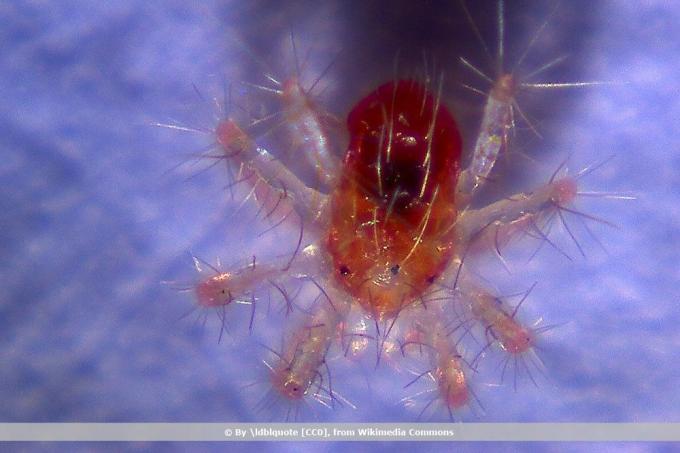
Mealybugs and mealybugs
If the humidity is low, mealybugs and mealybugs can be attacked on the Fatsia Japonica. They usually leave behind sticky leaf surfaces, white, cotton-wool-like webs and the leaves turn yellow before they fall off. An environmentally friendly home remedy reliably helps against this.
- Make highly concentrated soapy water from soft soap
- Wipe leaves with it or spray dripping wet with a spray bottle
- repeat after three to four days if necessary, then the problem should be solved
- ensure a higher level of humidity as a preventive measure
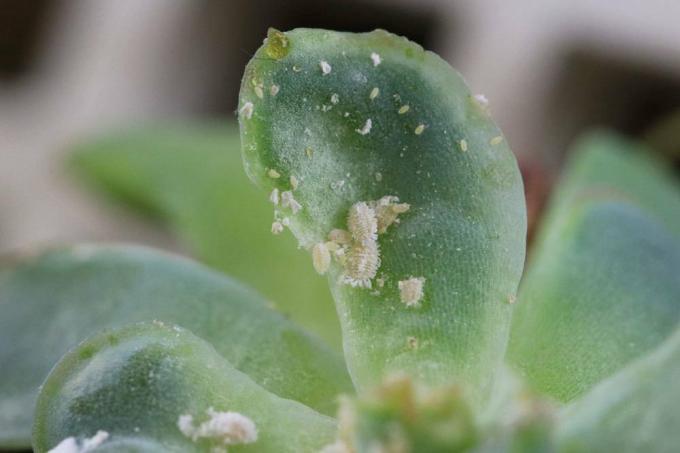
Aphids
There is hardly a green plant that aphids do not like. They are particularly widespread outdoors. They are usually difficult to distinguish from other louse species because they can come in a wide variety of colors, including green, yellow, black, as well as white and brown. Crippled and / or rolled up leaves, white-yellowish spots on the leaves and buds that have not opened or withered can indicate aphids. When fighting, you can follow the instructions under "mealybugs and mealybugs". The home remedy works equally well on aphids.
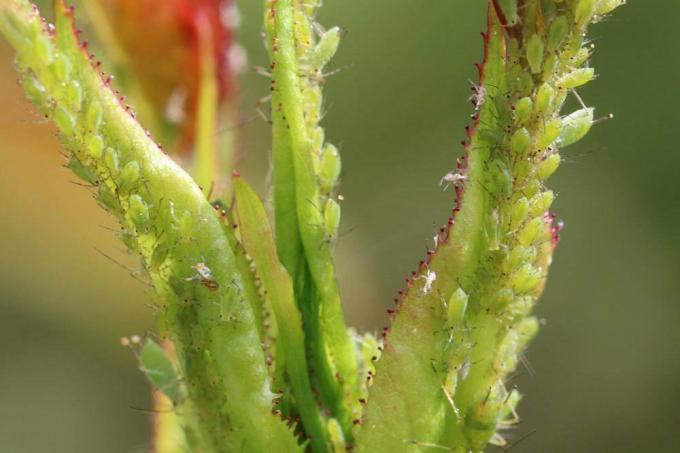
Is the indoor aralia poisonous?
Nobody knows why it is often said that the common aralia is poisonous, but this opinion is widespread, although it is not true. For people the Fatsia Japonica is not poisonous. So you can cut them without gloves and safely pluck dry leaves with your bare hand and let your children near the room aralia worry-free.
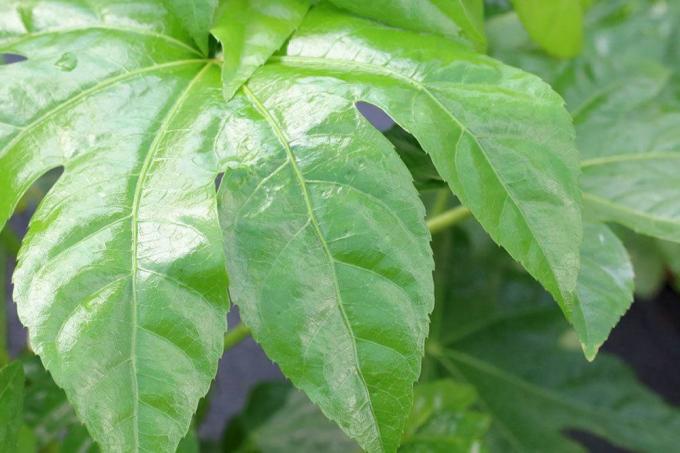
It is only poisonous for Cats. This is due to the fact that it contains so-called saponins, to which only cats react with irritation of the mucous membranes and typical symptoms of intoxication. However, it is so poisonous for cats that in the worst case scenario they can die from it.



